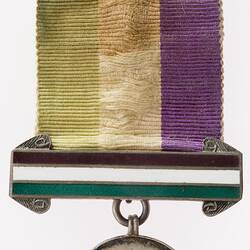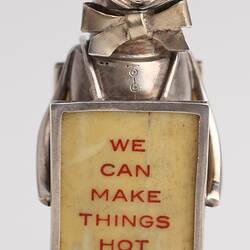Summary
Alternative Name(s): Spice Shaker, Sugar Shaker
Sterling silver, suffragette muffineer modelled as a woman wearing early 20th century dress, manufactured by Cornelius Desormeaux Saunders and James Francis-Hollings-Frank-Shepherd of London. It was registered between 28 March and 7 April 1908 in Chester, England.
Also known as a spice or sugar shaker, a muffineer is a castor used for sprinkling sweet spices on to food, such as bread and muffins. The head can be removed for the purposes of filling the muffineer with sugar or spices, and the bonnet has shaker holes. The figure has a sandwich board over its body which holds a protest placard at both the front and rear. It is an unusual souvenir of the suffrage movement, produced during its height of activity in England during the early twentieth century. The term suffrage refers to the mobilization of the suffrage movement in America, England, Australia and New Zealand between the 1880s and 1920s. The first wave of feminism created a new political identity for women with legal and political advances and social emancipation. The suffrage fight was wrapped up in issues to do with social justice and equality, social reform, particularly at home and in the workplace.
In about 1970 the muffineer was given to an antique jeweller in Melbourne; the item's provenance before then is unknown. The muffineer was kept in the jeweller's family until 2007, when it was donated to Museum Victoria.
Physical Description
Sterling silver shaker in the shape of a woman in early 20th century dress. Bonnet band and ribbon gold plated. Head with bonnet has 'shaker holes' and acts as a removable top for refilling the shaker. Leather base. The shaker has a front and a rear placard holder, into each of which is slotted a removable yellow acetate placard.
Significance
This shaker is an unusual souvenir of the suffrage movement, produced during its height of activity in England during the early twentieth century. Although acquired here, it is probable (although by no means certain) that this item was produced for an English rather than Australian market, at a time when the movement was running strong in England but with less heat in Australia post women gaining the federal vote in 1901 (and the same year they achieved the vote in Victoria, one of the last states to do so).The Museum holds very few items pertaining to female suffrage, and compliments the 1909 English suffragette medal (suffragists tend to fight for political equality via constitutional means; suffragettes take a more militant response). Women over 30 did not achieve the vote in England until 1918, and not until 1928 was the age limitation removed.
While the shaker has no strong Australian provenance, such items are unusual and will assist the Museum in telling broader histories about the Australian suffrage movement, which was intimately connected with the activities happening across the Empire. The object also has a story of adaptation, as the hand written reverse inscriptions presumably allude to the First World War; perhaps were even displayed on the dinner table as a political statement during the conscription debates, here or in England. This re purposing of the object from suffrage to war recruitment suggests interesting intersections of the themes of nation and gender. There is a degree of 'sassy' humour evident in the slogan and it would be intriguing to determine whether this is a piece commissioned by the movement, private individual, or a mass-produced item, presumably pro-suffrage. It is not clear whether the shaker is a domestic or even commercial item - used on a private dining table or a public restaurant? If private, it is an interesting introduction of the public political realm into the private domestic sphere.
The suffrage movement did spur the production of souvenirs and promotional items, as well as items generated for publicity and protest. This was particularly the case in the US and the UK. The Emily Howland collection in Sherwood New York, contains, aside from its substantial poster collection, a range of mass-produced suffrage ephemera produced by suffrage organisations and sold in specialised stores, local headquarters and through catalogues and at rallies and fundraisers. Items include: hats, blouses, badges, pins, valentines, kewpie dolls, playing cards, drinking cups, luggage tags, fans and hat pins. A German porcelain company Schafer and Vater (founded in Rudolstadt in 1896) produced a series of 20 or so statuettes which satirized the suffrage movement. There is also jewellery produced during the Edwardian period which has become known as 'suffragette jewellery'. There were jewellery items produced for the movement by commercial and craft jewellers but distinguishing pieces produced specifically for the Suffrage movement is extremely difficult and dealers appear to describe any jewellery item featuring the suffrage colours of purple, green and white as 'suffragette jewellery.' There are also pieces selected by suffragettes and worn because they feature the colours. In terms of sterling silver ware, little has been identified but was evidently produced. The National American Woman Suffrage Association commissioned a souvenir spoon for their suffrage convention in 1912. More research needs to be undertaken to ascertain whether there was a market in suffrage souvenirs here in Australia (neither the National nor Powerhouse museums appear to have any examples in their collections).
The term suffrage refers to the mobilization of the suffrage movement in America, England, Australia and New Zealand between the 1880s and 1920s. The first wave of feminism created a new political identity for women with legal and political advances and social emancipation. The suffrage fight was wrapped up in issues to do with social justice and equality, social reform, particularly at home and in the workplace. In England it resulted in an ongoing campaign of civil disobedience, with many women jailed and forced fed after hunger striking.
In Australia, the Australian Women's Suffrage Society was formed in 1889; while the Women's Christian Temperance Union, which also fought for social reform including women's voting rights, formed in 1887. The inaugural meeting of the Dawn Club, headed by publisher Louisa Lawson, was held in 1889. In 1891 a women's suffrage petition with 30,000 signatures was presented to the Victorian Parliament by various Christian and suffrage societies. In 1894 South Australian women were granted the right to vote, followed by Western Australia in 1899, New South Wales in 1902 and finally Victoria in 1908. Australian women (except Aboriginal women) were enfranchised in 1901.Women were not eligible for election to state parliaments until the end of WWII. Vida Goldstein was the first women in the British Empire to nominate for Australian Parliament (she ran unsuccessfully for the Australian Senate in 1902). Edith Cowen became the first woman parliamentarian in Australia in 1921. The anti-suffragette movement promoted women's inequality to men in terms of intellect and temperament, and therefore as incapable of contributing to public political life.
(Sources: www.abc.net.au/ola/citizen/women/women-home-vote.htm; Elizabeth Crawford, The Women's Suffrage Movement: A Reference Guide 1866-1928, Routledge 2001)
More Information
-
Collecting Areas
-
Acquisition Information
Donation from Ms Dimity Reed, 07 Sep 2007
-
Manufacturer
Cornelius Desormeaux Saunders & James Francis Hollings Frank Sheperd, London, England, Great Britain, 1908
-
Inscriptions
Printed in red upper case lettering on front placard: 'WE CAN MAKE THINGS HOT FOR YOU.' Printed in red upper case lettering on rear placard (very faint with wear): 'VOTES FOR WOMEN.' The reverse side of each placard has been inscribed in pencil: Reverse of front placard: 'WHAT ARE YOU DOING TO HELP YOUR COUNTRY?' Reverse of rear placard: 'YOUR KING & YOUR COUNTRY NEED YOU.' There are hallmarks on the side of the figure's skirt and the bonnet which have been identified as: Chester England 1908; Cornelius Desormeaux Saunders & James Francis Hollings -Frank-Shepherd, London.
-
Classification
-
Category
-
Discipline
-
Type of item
-
Overall Dimensions
22 mm (Width), 25 mm (Depth), 85 mm (Height)
-
Maximum dimensions
20 mm (Width), 25 mm (Depth), 85 mm (Height)
Measurement From Conservation.
-
Keywords
Suffrage Movement, Wars & Conflicts, Women's Suffrage, World War I, 1914-1918, Food Containers





